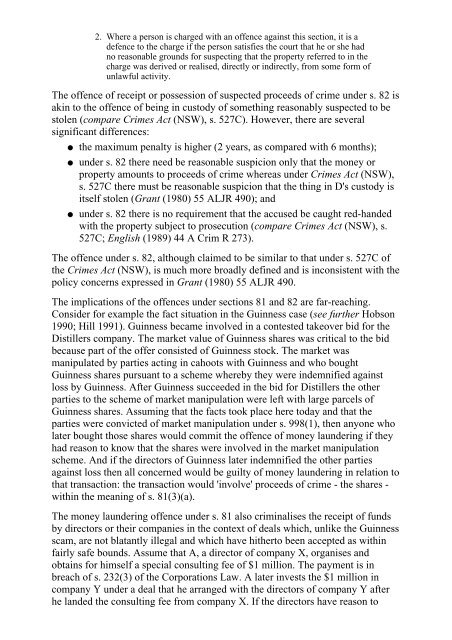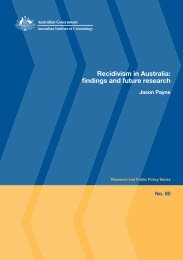Fraud and the liability of company directors - Australian Institute of ...
Fraud and the liability of company directors - Australian Institute of ...
Fraud and the liability of company directors - Australian Institute of ...
Create successful ePaper yourself
Turn your PDF publications into a flip-book with our unique Google optimized e-Paper software.
2.<br />
Where a person is charged with an <strong>of</strong>fence against this section, it is a<br />
defence to <strong>the</strong> charge if <strong>the</strong> person satisfies <strong>the</strong> court that he or she had<br />
no reasonable grounds for suspecting that <strong>the</strong> property referred to in <strong>the</strong><br />
charge was derived or realised, directly or indirectly, from some form <strong>of</strong><br />
unlawful activity.<br />
The <strong>of</strong>fence <strong>of</strong> receipt or possession <strong>of</strong> suspected proceeds <strong>of</strong> crime under s. 82 is<br />
akin to <strong>the</strong> <strong>of</strong>fence <strong>of</strong> being in custody <strong>of</strong> something reasonably suspected to be<br />
stolen (compare Crimes Act (NSW), s. 527C). However, <strong>the</strong>re are several<br />
significant differences:<br />
● <strong>the</strong> maximum penalty is higher (2 years, as compared with 6 months);<br />
● under s. 82 <strong>the</strong>re need be reasonable suspicion only that <strong>the</strong> money or<br />
property amounts to proceeds <strong>of</strong> crime whereas under Crimes Act (NSW),<br />
s. 527C <strong>the</strong>re must be reasonable suspicion that <strong>the</strong> thing in D's custody is<br />
itself stolen (Grant (1980) 55 ALJR 490); <strong>and</strong><br />
● under s. 82 <strong>the</strong>re is no requirement that <strong>the</strong> accused be caught red-h<strong>and</strong>ed<br />
with <strong>the</strong> property subject to prosecution (compare Crimes Act (NSW), s.<br />
527C; English (1989) 44 A Crim R 273).<br />
The <strong>of</strong>fence under s. 82, although claimed to be similar to that under s. 527C <strong>of</strong><br />
<strong>the</strong> Crimes Act (NSW), is much more broadly defined <strong>and</strong> is inconsistent with <strong>the</strong><br />
policy concerns expressed in Grant (1980) 55 ALJR 490.<br />
The implications <strong>of</strong> <strong>the</strong> <strong>of</strong>fences under sections 81 <strong>and</strong> 82 are far-reaching.<br />
Consider for example <strong>the</strong> fact situation in <strong>the</strong> Guinness case (see fur<strong>the</strong>r Hobson<br />
1990; Hill 1991). Guinness became involved in a contested takeover bid for <strong>the</strong><br />
Distillers <strong>company</strong>. The market value <strong>of</strong> Guinness shares was critical to <strong>the</strong> bid<br />
because part <strong>of</strong> <strong>the</strong> <strong>of</strong>fer consisted <strong>of</strong> Guinness stock. The market was<br />
manipulated by parties acting in cahoots with Guinness <strong>and</strong> who bought<br />
Guinness shares pursuant to a scheme whereby <strong>the</strong>y were indemnified against<br />
loss by Guinness. After Guinness succeeded in <strong>the</strong> bid for Distillers <strong>the</strong> o<strong>the</strong>r<br />
parties to <strong>the</strong> scheme <strong>of</strong> market manipulation were left with large parcels <strong>of</strong><br />
Guinness shares. Assuming that <strong>the</strong> facts took place here today <strong>and</strong> that <strong>the</strong><br />
parties were convicted <strong>of</strong> market manipulation under s. 998(1), <strong>the</strong>n anyone who<br />
later bought those shares would commit <strong>the</strong> <strong>of</strong>fence <strong>of</strong> money laundering if <strong>the</strong>y<br />
had reason to know that <strong>the</strong> shares were involved in <strong>the</strong> market manipulation<br />
scheme. And if <strong>the</strong> <strong>directors</strong> <strong>of</strong> Guinness later indemnified <strong>the</strong> o<strong>the</strong>r parties<br />
against loss <strong>the</strong>n all concerned would be guilty <strong>of</strong> money laundering in relation to<br />
that transaction: <strong>the</strong> transaction would 'involve' proceeds <strong>of</strong> crime - <strong>the</strong> shares -<br />
within <strong>the</strong> meaning <strong>of</strong> s. 81(3)(a).<br />
The money laundering <strong>of</strong>fence under s. 81 also criminalises <strong>the</strong> receipt <strong>of</strong> funds<br />
by <strong>directors</strong> or <strong>the</strong>ir companies in <strong>the</strong> context <strong>of</strong> deals which, unlike <strong>the</strong> Guinness<br />
scam, are not blatantly illegal <strong>and</strong> which have hi<strong>the</strong>rto been accepted as within<br />
fairly safe bounds. Assume that A, a director <strong>of</strong> <strong>company</strong> X, organises <strong>and</strong><br />
obtains for himself a special consulting fee <strong>of</strong> $1 million. The payment is in<br />
breach <strong>of</strong> s. 232(3) <strong>of</strong> <strong>the</strong> Corporations Law. A later invests <strong>the</strong> $1 million in<br />
<strong>company</strong> Y under a deal that he arranged with <strong>the</strong> <strong>directors</strong> <strong>of</strong> <strong>company</strong> Y after<br />
he l<strong>and</strong>ed <strong>the</strong> consulting fee from <strong>company</strong> X. If <strong>the</strong> <strong>directors</strong> have reason to















